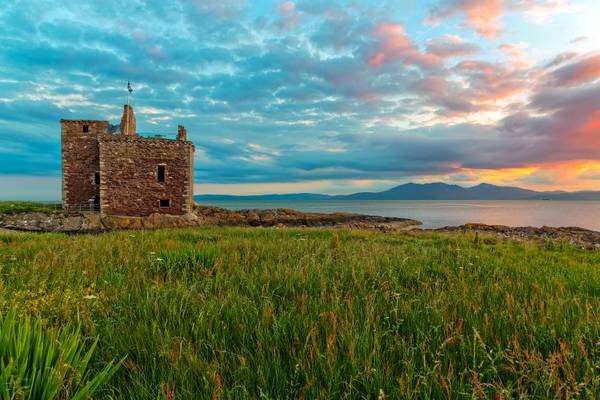
Portencross Castle

by Michael Kight
On our recent trip to the United Kingdom, I was actually on assignment to photograph castles, and anything else, associated with Clan Boyd. The day we arrived in Glasgow, Scotland, was a day of many “firsts” for me, one of them being driving a totally different way than we do in the states, on the left-hand side of the street from the right-hand side of the car. It helped that I had spent a few days with my friend Peter Williams (www.flickr.com/photos/diskdoc/) in Brighton, England, seeing how it’s done and finding out how the road system and signs equated with those here in the states. There wasn’t a world of difference, yet there was a difference. Somehow, my brain just clicked into it, and, as I much enjoy driving, the difference was enough that I felt much like I was at a ride in an amusement park... I loved it!
The first few nights there, we stayed at Airth Castle, which was built by Robert the Bruce, a contemporary of Robert Boyd. We checked in, situated room and luggage, and had plenty of time left for dinner, and an hour and a half drive to here, Portencross... if I could only get that English chick (the name I applied to the British female voice) on the GPS to understand my southern vernacular. It took us a good many minutes to program it: “Say the town.” “Portencross” “That word is disambiguous.” “Arrrrrgh!” “That word is disambiguous.”
What also made driving here such an experience wasn’t merely the situational issue of car and road... it was the fact that many of the roads here were ridiculously narrow. The drive out from Airth seemed much like driving in a funnel... the closer we got to the coast, the closer the roadside got. Every time someone passed by on the other side of the road, I heard Joyce say, “You came awfully close over here!” Well, they came awfully close over on my side too... but that was part of the fun! We saw more than a few cars with the side-mirror dangling apparently from such an encounter. Obviously, jousting is still somewhat still in vogue in the UK.
Having survived the drive to Portencross, we grabbed camera and gear, and hoofed it to the castle. You may be thinking the same thing I did... big, blocky structure in the middle of nowhere... quite underwhelming... until you realize the significance of this place. The lands around Portencross were given to the Boyds of Kilmarnock by King Robert I for their help at the Battle of Bannockburn... this is the seat of the House of Boyd. An exact history of this place will likely never be known, yet from its beginning around 1360, there have been indicators that Portencross Castle may have been a royal residence, as it is known that several charters of the first two Stuart kings were signed there.
Legend has it that the castle may have been the last mainland resting place for past Scottish kings. For over two hundred years, the bodies of former kings were taken by road to Portencross where they were ferried to Iona where they would be buried. If it is legend, it’s an astounding one.
There’s something sacred about that... I had that on my mind as I worked to find a “just right” composition of this “blocky” form. There’s history here. I’m overlooking the Firth of Clyde from the shores of County Ayrshire in Scotland, much the same way that my wife’s ancestors did nearly 700 years ago... and I thanked God for them... and for her. Without them, there would be no "her"... and she brings something that was missing into my life. History unfolds here, and in it I see some of who she is.
We had a lot to talk about on the drive back to Airth. The "English chick" was left out of the conversation, however.

by The Jacobite
Portencross Castle is situated on a rocky outcrop in north Ayrshire Scotland overlooking the Firth of Clyde, it dates back to the 14th century and legend has it that it was the last resting place of the great kings of Scotland. where they lay in state before being transported to the west coast Isle of Iona for burial.

by Dee Eff
Got this whilst dodging rain showers.
Thanks to all Phoide contributors to Portencross Castle!
Most notably Michael Kight, Dee Eff and The Jacobite.